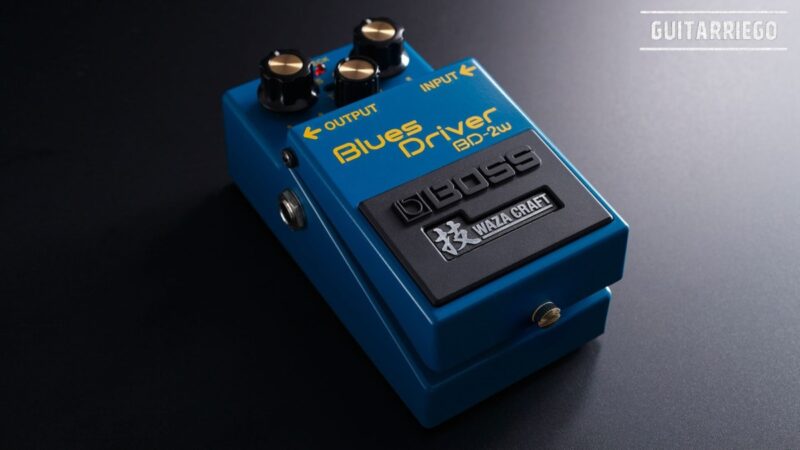Ukulele Sizes, What is Best For You?

Main ukulele sizes: soprano, concert, tenor, and baritone, their body size and neck length, sound and playability of each type of uke, includes tips for choosing the best for you.
Ukulele Sizes: Soprano, Concert, Tenor, or Baritone?
Welcome to our comprehensive guide on ukulele sizes! If you’ve ever been curious about the various dimensions and sounds of ukuleles, you’re in the right place. In this article, we’ll delve into the world of ukuleles, focusing on the four most popular sizes: soprano, concert, tenor, and baritone.
We’ll not only explore the unique characteristics of each size but also provide you with valuable insights to help you determine which one is the perfect match for your musical aspirations. Whether you’re a seasoned ukulele player or just starting your ukulele journey, understanding the distinctions between these sizes is crucial for making an informed choice. So, let’s embark on this musical adventure together as we uncover the intricacies of ukulele sizes and discover which one suits you best.
With the perfect uke size for you, you can play more easily the best songs on ukulele for beginners.
Ukulele Sizes
- Soprano
- Concert
- Tenor
- Baritone
Soprano
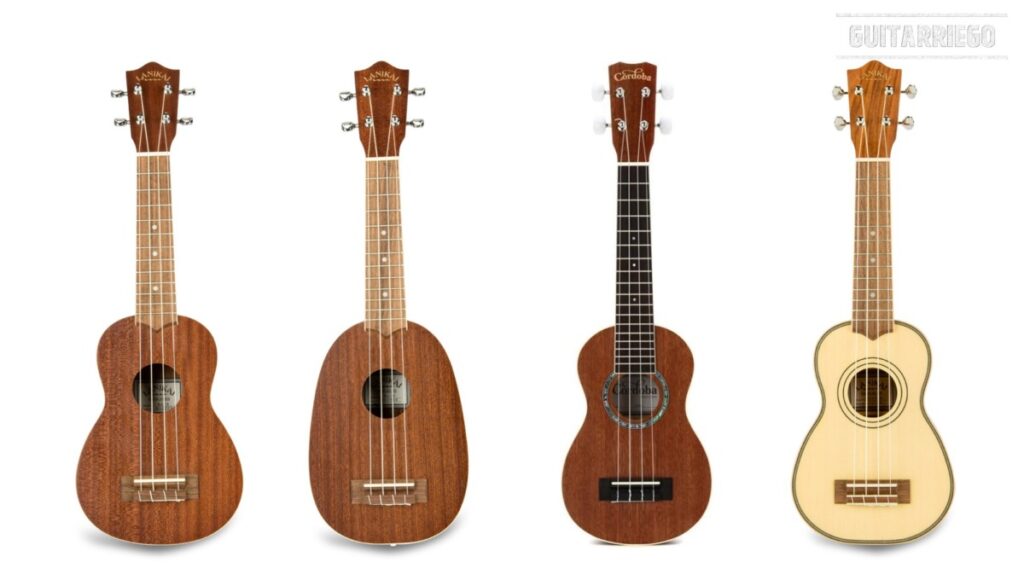
Let’s start with the smallest of these four sizes, which is the soprano or the standard ukulele. This was the original size of the uke. The Soprano Ukeleles use the standard GCEA tuning.
A general rule with ukuleles, and many other instruments, is that the smaller the body, the higher the pitch. While this might make it seem louder to our ears, it’s primarily about the pitch itself. Soprano ukuleles have a very small body and a small neck, that why these tend to sound a bit more trebly.
Soprano ukuleles are great for strumming chords. Their small size makes them easy to hold, and they have a traditional ukulele sound. However, they are not ideal for playing single notes up the neck, as they tend to go out of tune as you move higher. Additionally, soprano Ukes typically have only twelve frets and little playing space on the fretboard.
Finally, Soprano ukes are very transportable, making them an excellent option for those who want to take them everywhere. Soprano ukuleles also come with pineapple shape, that some people confuse with other size, but actually it’s a Soprano with just other shape.
If you’re looking for a ukulele that’s perfect for strumming chords and has that classic ukulele sound, the soprano size is a great choice. Just keep in mind that it may not be the best option if you want to play intricate melodies or single notes up the neck.
It’s important you know well the parts of the Ukulele.
Concert
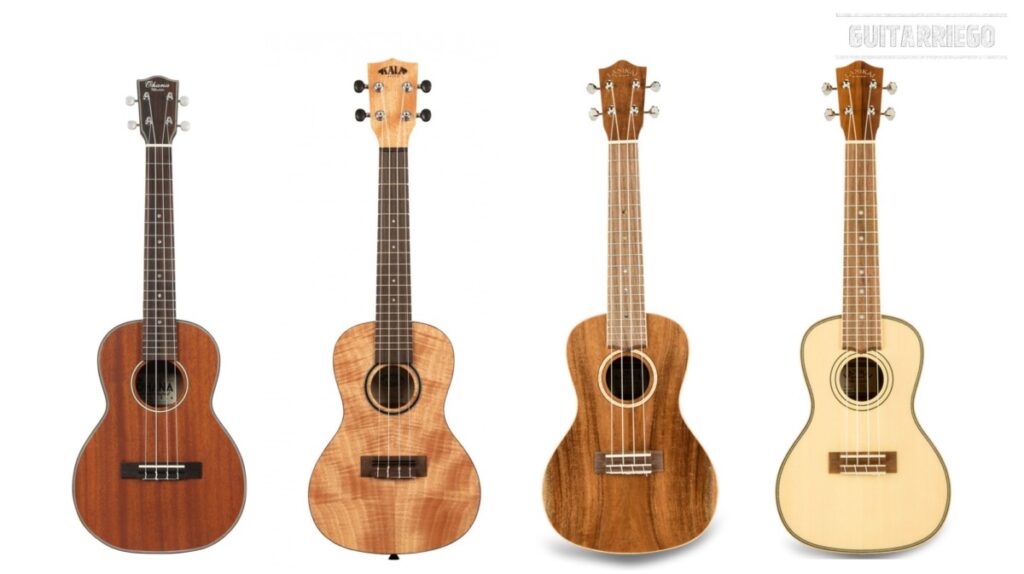
Now, let’s dive into the enchanting world of concert-sized ukuleles. The Concert ukuleles use the standard GCEA tuning. Positioned between the petite soprano and the larger tenor, the concert ukulele strikes a harmonious balance, making it a favorite among many players. Compared to the soprano, the Concert Ukelele has a slightly bigger body and a longer neck. The bigger body of the Concert uke produces more mid-range and a bit more bass.
Concert Ukuleles usually have between seventeen and eighteen frets. Whether you’re drawn to strumming sweet chords or plucking melodious single notes, the concert ukulele offers a versatile and delightful experience. Also, it should be noted that concert ukuleles stay in tune better than their smaller-sized counterparts, ensuring that your music flows smoothly down the neck.
Tenor

Let’s venture into the world of tenor-sized ukuleles, where the music takes on a rich and vibrant character. Like Soprano and Concert, the Tenor ukuleles use the standard GCEA tuning. With a larger body and a longer neck compared to the concert and soprano sizes, the tenor ukulele offers a remarkable sonic landscape. The tenor produces even more mid-range and bass, and it’s slightly louder. This size is favored by musicians who appreciate the versatility of strumming chords and playing intricate single-note melodies. This is the easier size to play because you have more space in the fretboard and because the tenor ukulele is more stable in your hands. Usually, Tenor Ukes have between seventeen and twenty frets.
Additionally, the choice between high G and low G strings is very common on this size of ukulele, which can significantly expand the range and tonal diversity of your playing.
Don’t miss our tutorial about tutorial about Ukulele chords for beginner uke players.
Baritone

Finally, let’s turn our attention to the captivating world of the baritone-sized ukulele. Distinguished by its larger body and extended neck, the baritone ukulele offers a unique and resonant musical experience. It’s essentially the size of a 1/4 or tenor guitar without the fifth and sixth string. Therefore, this size is often likened to that of a guitar, bridging the gap between ukuleles and guitars. Usually, Baritone Ukuleles have between seventeen and twenty frets.
One essential distinction to note is the tuning of the strings, which is different from the soprano, concert, and tenor ukuleles. Baritone ukuleles typically use a DGBE tuning, similar to the four highest-pitched strings of a guitar. This unique tuning lends the baritone its distinct sound, characterized by a warm and robust low end. If you’re drawn to a mellower, guitar-like tonality and a broader sonic range, the baritone ukulele may be the perfect choice for your musical journey.
Keep in mind that due to its distinct tuning, you’ll want to explore resources and materials tailored specifically to the baritone ukulele to make the most of this extraordinary instrument. Additionally, the baritone ukulele loses the transportability quality that soprano and concert ukuleles have.
Ukulele sizes measurements
When measuring a ukulele, simply measure from the nut down to the saddle. Now, let’s demystify the measurements of each ukulele size to help you make an informed choice:
- Soprano Ukulele: The soprano or standard ukulele is the smallest of the four most popular sizes and typically has a scale that measures between 13 and 14 inches long. Its compact size makes it portable and easy to handle.
- Concert Ukulele: Slightly larger than the soprano, the concert ukulele has a scale that typically measures between 14 and 15 inches long. This extra size allows for a bit more resonance and a comfortable playing experience.
- Tenor Ukulele: Stepping up in size, the scale of the tenor ukulele measures around 17 inches in length. Its increased length contributes to richer mid-range and bass tones, making it ideal for both strumming and fingerpicking.
- Baritone Ukulele: The baritone ukulele is the largest of the main ukulele sizes, with a scale length of approximately 19 inches. Its extended size allows for deeper, more guitar-like tones, offering a unique sound within the ukulele family.
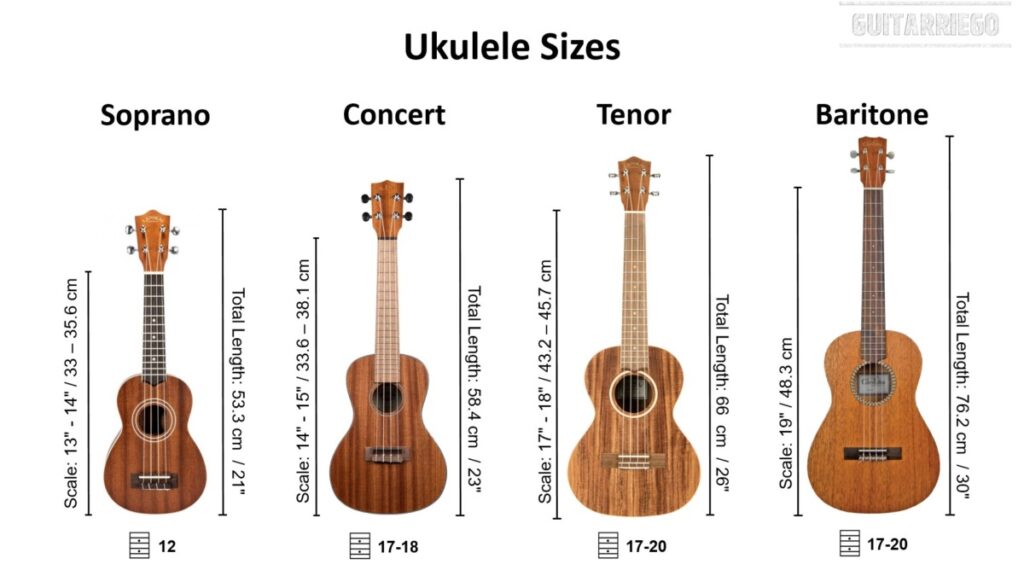
Understanding these measurements is key to selecting the ukulele size that suits your playing style and tonal preferences. Whether you prefer the petite soprano or the robust baritone, each size offers a distinct musical experience.
If you have already chosen the perfect uke size for you, visit this selection of the best cheap ukuleles for beginner players.
Other Uke sizes: Sopranissimo, Sopranino, Bass and Contrabass
There other not so common and popular ukulele sizes that are the Sopranissimo and Sopranino that are smaller to the Soprano with 11″ and 12″ scale length respectively. These sizes just don’t sound great and they also don’t intonate well.
On the other hand, there are the Bass and Contrabass Ukulele with a larger body and a longer neck compared to the tenor and baritone ukes. The Bass sized has up to 21″ scale length while the Contrabass has up to 23″ scale length. The Bass and Contrabass Ukes don’t use standard uke strings, instead they use thicker strings that give it a tone similar to a bass guitar. These ukuleles are great for bass player. Both sizes are like pocket basses, and have a great sounding.
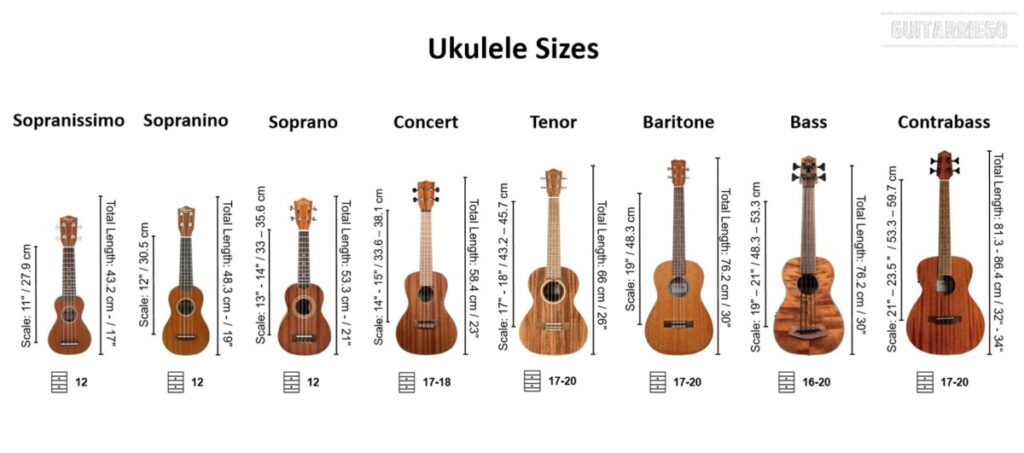
Which ukulele size is right for you?
There are many different choices, including various woods, from solid to laminate, koa to spruce. Our favorite ukulele is the Tenor, as it gives a broader playing experience mainly due to its larger size. On the other hand, if you want the original bright, happy sound of the ukulele, and will only be playing songs by strumming chords, the soprano or standard is your best option.
On the other hand, if you are still not sure you can go to an intermediate point which is the concert ukulele. It’s a versatile size, neither too big nor too small, suitable for both strumming chords and playing single notes.
Your choice should also consider your hand size and personal preference. If you’re taller with large hands, a tenor might be better. If you’re smaller with smaller hands, consider a soprano or concert. In case you’re ordering online without trying them out physically, a concert is a safe bet.
Remember that the baritone has a different tuning, so only go for it if you specifically want that sound.
Final Thoughts on Ukulele Sizes
We’ve covered the different sizes of all the types of ukulele, their sounds, and how to measure them. We hope this information helps you choose the right ukulele for your musical journey. There are many exciting ukulele companies out there making a variety of instruments, such as Lanikai, Kala, Ohana, Luna, among others, so it’s an excellent time to become a ukulele player!
Let us know if you have any doubts or questions below in the comment section.
Finally, we strongly suggest you to use before every practice our Free online Ukulele Tuner with microphone for all tunings.





